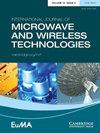通过极化转换寄生结构引入正交模式,增强 MIMO 贴片天线的隔离效果
IF 1.3
4区 计算机科学
Q3 ENGINEERING, ELECTRICAL & ELECTRONIC
International Journal of Microwave and Wireless Technologies
Pub Date : 2024-04-26
DOI:10.1017/s1759078724000461
引用次数: 0
摘要
本研究提出了一种利用正交模式消除方法的高隔离多输入多输出(MIMO)微带贴片天线(MPA)。该方法采用 TM10 和 TM01 模式,这两种模式同时在矩形无源 MPA 中激发。最初,设计了一种具有极化旋转特性的矩形去耦结构。进一步的研究表明,通过加载极化转换寄生结构(PCPS),空间耦合波的电场可以从 x 极化 TM10 模式转变为 y 极化 TM01 模式。因此,来自激励天线和去耦结构的 TM10 和 TM01 模式同时耦合到无源天线上,在无源天线上形成一个明显的弱场区域。将无源 MPA 的馈电探头置于弱场区域内,可防止端口接收信号。因此,在谐振频率为 5.8 千兆赫时,相互耦合度极低,为-49 分贝。最后,我们制作并测试了拟议天线的原型,测量结果与模拟结果非常吻合。此外,还观察到 PCPS 对多输入多输出天线的性能略有影响。本文章由计算机程序翻译,如有差异,请以英文原文为准。
Introduction of the orthogonal mode via the polarization conversion parasitic structure for the isolation enhancement of MIMO patch antennas
In this study, a high-isolation multiple-input multiple-output (MIMO) microstrip patch antenna (MPA), which utilizes an orthogonal mode cancellation method is proposed. This method employs TM10 and TM01 modes, which are simultaneously excited in the rectangular passive MPA. Initially, a rectangular decoupling structure featuring polarization rotation characteristics is designed. Further studies show that by loading the polarization conversion parasitic structure (PCPS), the electric field of the spatial coupling wave can be transformed from the x -polarized TM10 mode to the y -polarized TM01 mode. Therefore, TM10 and TM01 modes from the excited antenna and decoupling structure are concurrently coupled to the passive antenna, forming an evident weak-field region on the passive antenna. Placing the feeding probe of the passive MPA within the weak-field region prevents signal reception at the port. Consequently, this results in an extremely low mutual coupling of −49 dB at a resonant frequency of 5.8 GHz. Finally, a prototype of the proposed antenna is fabricated and tested, and the measured results closely match the simulated results. Additionally, it is observed that PCPS slightly influences the performance of the MIMO antenna.
求助全文
通过发布文献求助,成功后即可免费获取论文全文。
去求助
来源期刊

International Journal of Microwave and Wireless Technologies
ENGINEERING, ELECTRICAL & ELECTRONIC-TELECOMMUNICATIONS
CiteScore
3.50
自引率
7.10%
发文量
130
审稿时长
6-12 weeks
期刊介绍:
The prime objective of the International Journal of Microwave and Wireless Technologies is to enhance the communication between microwave engineers throughout the world. It is therefore interdisciplinary and application oriented, providing a platform for the microwave industry. Coverage includes: applied electromagnetic field theory (antennas, transmission lines and waveguides), components (passive structures and semiconductor device technologies), analogue and mixed-signal circuits, systems, optical-microwave interactions, electromagnetic compatibility, industrial applications, biological effects and medical applications.
 求助内容:
求助内容: 应助结果提醒方式:
应助结果提醒方式:


